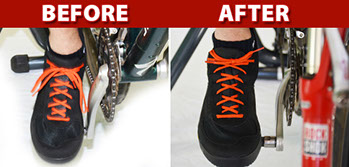Cycling Knee Injury
Despite the fact that the knee joint moves the most during cycling vs other sports, and the most force is created through the knee via the quadriceps muscle, a cycling knee injury is a relatively rare phenomenon. In fact, many athletes in other sports such as football, basketball, soccer, etc. that put a pounding on the knee joint and whose athletes suffer such injuries as torn meniscus (cartilage) and torn anterior cruciate ligaments ( ACL) or medial collateral ligaments ( MCL) are usually rehabed back to health with the use of a cycle ergometer combined with strength training.
The more common cycling knee injury will be repetitive motion problems due to faulty underlying biomechanics that cause an overuse syndrome. These include quadriceps or patellar tendonitis, ilial-tibial band syndrome and rarely hamstring tendonitis. Rarely will there be an injury from cycling be an actual knee joint issue. Even those people with severe degenerative joint disease of the knee joint are usually able to cycle on a bike and benefit from it. There is not the trauma to the joint that there is with weight bearing exercise. The perfect bike fit for an individual and his/her bike means the marriage of the two is also perfect. This means the various settings of seat height, saddle position, foot/cleat position, toe-in vs toe-out, stem height and/or stem length and Q factor distance must be optimized to the specific individual's unique biomechanics, geometry, flexibility and goals. Foot pronation and/or supination is another often critical fitting factor that is often missed and best fixed by custom made cycling orthotics that are worn in one's everyday shoes as well as in their cycling shoes. Keeping the foot in a neutral position has tremendous benefits for knee function when riding.
The Q factor is an often overlooked factor in bike fitting that when ignored, is a major contributing factor to cycling knee injury. Lateral knee pain is very commonly related to a Q factor that is too narrow as is pain from the foot all the way up to the hip while riding in many cyclists. The Q factor specifically is the distance between the feet when placed on the pedals. Road bikes tend to have a narrower Q factor than mountain bikes due to a narrower bottom bracket. Recumbent cyclists often benefit from a wider Q factor due to the natural "knees out" position one's knees assume when in the sitting position.
When I began bike fitting in the mid-1980's it became apparent to me that there was need to move people's feet apart to a wider position on the pedals for all sorts of reasons including larger body size, larger feet, a toe out gait pattern, bow legged structure and various other biomechanical issues. Often times the problem is on one side only often due to an old fracture with healing of the foot in an outward bound position that the bike must be fixed to accommodate.

Mobile Bike Fitting Services Available
Randy Ice PT, CCS offers a mobile bike fitting program that can resolve your pain syndrome and/or optimize your power output where others have failed. He travels all over Southern California to make the process easy for you.
Call (760) 468-4718 for more information or an appointment. The following "Principles of Bike Fitting: What Factors Make For An Optimal Fit" PowerPoint Presentation will take you through the process of achieving an optimal bike fit and the how to's of relieving/preventing cycling biomechanical pain syndromes. The little understood and discussed "Q Factor" as well as the development of Kneesavers™ is also presented.
Optimal Bicycle Fitting:
What Factors Make For An Optimal Fit

